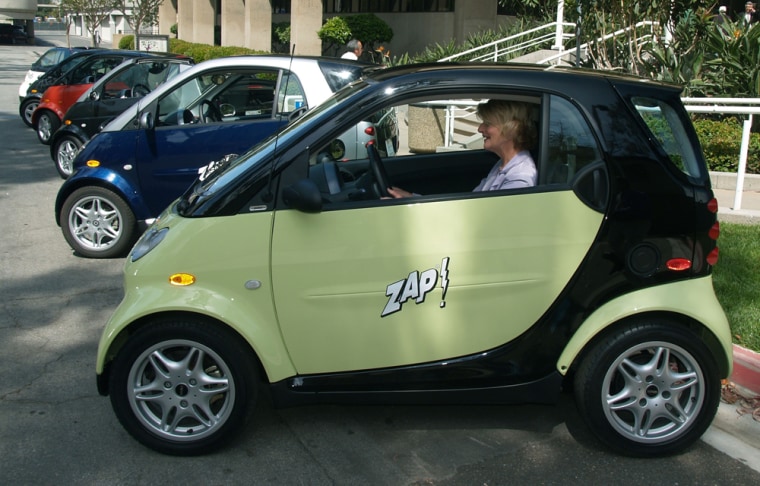In America everything, they say, is bigger. But when it comes to automobiles, is the smaller, more fuel-efficient car about to become the next big thing in motoring?
ZAP certainly hopes so.
The Santa Rosa, Calif.,-based manufacturer of electric motor powered bicycles and power-assisted kit cars plans to sell DaimlerChrysler’s Smart Cars — first launched in Europe and now seen on the roads of most European nations and also in Africa, Asia, Canada and Mexico — in the United States, seeing a big niche market for very small cars.
The thinking is, with gasoline prices hitting record highs and traffic in the nation’s major cities becoming increasingly congested, Americans are likely to buy fewer gas-guzzling SUVs and trucks and gravitate toward smaller, more efficient vehicles like the Smart Car — a mere 8 feet, 2 inches long and just over 5 feet tall — according to ZAP’s CEO Steve Schneider.
“The market timing for what we are doing couldn’t be better,” Schneider said. “Fuel prices are at all time highs, and social responsibility about global warming is something that’s more in the mainstream and not a left-wing thing,” he added. “And there’s the issue of our dependency on foreign oil too — all this makes our business plan very timely.”
ZAP’s plan is to sell 15,000 Smart Cars updated to American road standards through its U.S. distribution network of dealers. Schneider said he already has some $2 billion in orders, far exceeding his initial goal of $300 million, and is preparing the 2005 model year Smart Cars — the first it intends to Americanize and offer through its dealer network by September.
DaimlerChrysler halted its plan to bring the tiny car stateside, and so ZAP has worked instead to buy the vehicles from a network of independent European suppliers, updating them for U.S. use to meet American safety and pollution standards. ZAP plans to sell the coupe version of the car for around $21,000 and the convertible for $25,000. In Europe, the Smart Car coupe sells for about $15,000 and the convertible for $18,000.
At about half the size of most mid-size cars, the two-seater, ForTwo Smart Car is powered by a three-cylinder engine and big enough to hold two adult passengers. It does 50 miles to the gallon and has a cruising speed of about 85 miles per hour.
But the question of whether your average American is ready to swap an SUV for a dinky smart car remains uncertain, according to industry experts.
“Not many people are scared into buying a fuel efficient vehicle just yet,” said Tom Appel, editor of Consumer Guide Automotive, an auto buyer’s guide. “Americans are avoiding cars and trucks that get very bad fuel efficiency, like GM’s Tahoe and Yukon, but they are not really going for cars that give very good fuel efficiency,” he added. “Fuel economy is not the foremost consideration for American buyers — we’re getting used to the price of gas.”
Scott Miller, CEO of Detroit-based Synovate Motoresearch, a division of Chicago-based market research firm Synovate, says his research shows fuel efficiency is not a primary concern for U.S. consumers, who are more concerned with style and space. However, if energy prices spike they could quickly warm up to vehicles like the Smart Car, he said.
“In the U.S., we have not hit that threshold yet, but we don’t know where that point is, and one thing people don’t know for sure is what will happen with energy prices,” said Miller. “There is a tipping point, and if people see oil prices move up to $100 a barrel, or the price of gasoline at $4 a gallon, I think their priorities will start to change.”
At the moment there is no sign of a desire for a trade-off, he added.
“Everyone wants a fuel-efficient vehicle, but very few people want to give up styling, or cargo space, or acceleration to get it, so you’re seeing manufacturers putting fuel-efficient hybrid technologies into their existing vehicles” Miller said. “It’s all about trade-offs, and right now you don’t have the market dynamics to push more fuel efficient vehicles.”
While there is no overall U.S. trend toward smaller cars, they might find a market in large U.S. cities, where consumers make short trips and struggle to find parking spaces, or among more environmentally-conscious younger consumers said Phil Reed, consumer advice editor at car buyer's guide Edmunds.com.
“The Toyota Prius is a good example of a car that is both fuel efficient and very popular,” Reed said. “It has gone beyond the environmentalist and it’s now selling to people who want to be seen to be green; people who want to be prepared for an uncertain future with higher gas prices.”
One challenge for the Smart Car is sex appeal, said David Thomas, online editor at MPH Car Magazine. While the chic, retro Mini Cooper has successfully bucked the American trend toward big, powerful cars, like trucks and SUVs, the Smart Car lacks the same image, he said, and so is unlikely to garner the same broad U.S. appeal.
“If you drive a Smart Car you are making a statement, but is it the right statement?” he said. “The Mini has a sporty feel to it; there’s a performance aspect. It’s done really well here in the U.S. and it’s selling at a premium price. For Americans, status is a big deal and the Smart Car doesn’t have the same connotation to it. That’s the European-American divide right there.”
